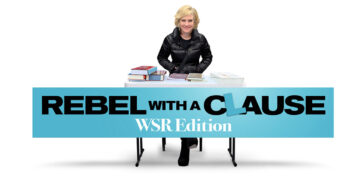
UPDATE: The Rag is republishing our story from last month about curbside composting, the city program that expands to Manhattan this week. Read here for details on the collection program, why composting is important, and what happens to the organic waste collected by the city. To see when compost is collected in your neighborhood click HERE.
By Scott Etkin
November 5 is a day that everyone has marked on their calendars this year, but there’s another important date for New Yorkers (including Upper West Siders) a month before that: October 6. That’s when the city’s Department of Sanitation (DSNY) begins collecting compost from all residential buildings in Manhattan, the final step in the citywide rollout of its curbside composting program.
“Curbside composting” refers to the collection of organic material – food scraps, food-soiled paper, leaves, and soil – separate from what’s traditionally collected in NYC: trash, and the recycling materials glass, plastic, metal, and paper. Starting October 6, DSNY will begin collecting compost once a week, on the same day it picks up recycling from buildings in the neighborhood.
No advance sign-up is needed, but buildings need to follow a few rules: Compost should be set out for collection in bins that have a secure lid, that hold 55 gallons or less, and that are lined with a clear plastic, paper, or compostable bag. “Owners of buildings with four units or more must provide a storage area and clearly labeled bins for the composting,” according to DSNY’s website.
Buildings can use their own bins or order a free one from DSNY. Decals are also available to download for free to label the bins.
According to a 2023 study by DSNY, one-third of what New Yorkers put in trash is material that could be composted. The goal of curbside composting is to stop this organic material from being sent to trash landfills, where it decomposes into methane, a harmful gas, and instead collect it for processing into “compost for parks and gardens, or into renewable energy and fertilizer,” a DSNY representative wrote in a message to West Side Rag.

Today, much of the organic material that’s collected is processed in huge digester eggs at the NYC Department of Environmental Protection’s Newtown Creek facility in Greenpoint, Brooklyn. There, it is converted into a mix of biosolids – which can then be used for fertilizer and ground cover – and biogas (mostly methane), that’s used as energy by National Grid, a utility company that serves New York and Massachusetts, and to heat the facility itself.
Besides the positive environmental impact of composting, the use of sealed bins to store organic material might also help reduce New York’s rat population. “Curbside composting is an important part of the city’s war on rats,” the sanitation department representative wrote to the Rag. “By removing food waste from black bags and putting it into sealed containers, we take rat food off our streets. And if rats can’t feed, they can’t breed.”
Curbside composting is already underway in Brooklyn and Queens. When Staten Island, the Bronx, and Manhattan also start receiving the service in October, it could be considered the biggest change to residential sanitation in NYC since 1989, when recycling became mandatory. So far, the program’s implementation in Brooklyn and Queens “has diverted near record numbers of food and yard waste from landfills – and we expect those numbers to rise as this program expands citywide,” wrote the sanitation representative.
To watch a previously recorded information session on composting, click – HERE.
Subscribe to West Side Rag’s FREE email newsletter here.









I wonder what will happen with all these bins?
Do we think they will be stolen when they are put out? When I put them out, most likely I will need to wait around to bring them back behind our locked gate after they are emptied.
The locking lids do not seem to help with rats, maybe a raccoon could lift an unlocked lid. Doesn’t seem likely a rat could scale the bin and lift the lid.
Please also put your garbage in cans to keep sidewalks clean and rat free.
Garbage will no longer have food in it, so rats will not be interested.
This will only be true if everyone bothers to compost. I expect, and this is optimistic, that maybe 20% of people will do so. It’s just too much trouble to expect most people to do it.
“That’s when the city’s Department of Sanitation (DSNY) begins collecting compost from all residential buildings in Manhattan.”
Today is October 6. According to the staff, our 65-unit building, whose owners are generally very law-abiding, seems to have gotten no word on composting, no bins, no information on how tenants are to handle food scraps for composting. As of now, we’re still tossing bagged trash down the compactor and using blue recycling bins for paper, glass, metal and plastic. Perhaps DSNY is a bit optimistic about its roll-out dates?
Enforcement does not begin until April 2025. That may be why buildings are waiting.
Same thing in my building. No informational flyers, no brown bins, nothing. Somehow I don’t think this is working yet.
Always wondered: Does taking biodegradable contents out of trash increase the time it will take for the remainder to break down?
Is the city going to give away small sealable containers to apartment dwellers to keep on their counters? I know some people who live in towns where they gave out small sealable containers. You don’t smell the contents and they didn’t get little creatures. Otherwise I don’t see apartment dwellers doing this. I will drop off stuff in the basement on my way out in the morning, but I will not late at night after cleaning up the kitchen.
Maybe WestSideRag can investigate this.
Easy enough to make your own small, sealable container. Use one of those quart take-out containers, line it with a compostable bag, and put the lid on. Won’t work for things like corn husks and cobs or mussel shells, but works perfectly for most food scraps. And it doesn’t attract bugs so it doesn’t need to be emptied until full.
Use you freezer
Freezer is too small to do this. Have they thought out where you are supposed to put these 55allon bins?? A big building is going to need a lot of bins if pick up is only once a week. And not one word of this from my building.
Unfortunately, more often than not, the people who are picking up the compost bins are spilling a lot of the food on the curb – a feast for the rats. I see this numerous times when walking my dog in the morning and it is usually there in the evening if it is in front of a brownstone with no super to clean it up.
When Dept of Sanitation places more litter baskets on the curbs and learn how to empty the compost bins without spilling, I would be more apt to compost.
On our street, rat populations have decreased significantly since composting began in earnest. We have at least 15 bins on our street that attract far fewer rats than the soft, easily penetrable plastic garbage bags.
You can always use a smart bin
Both Nov. 5 and Oct. 6 involve similar activities: getting rid of garbage.
I didn’t notice any mention of this being mandatory or not….so checked the NYC311 site:
— Leaf and yard waste separation from trash is mandatory. There is a warning period for 3 months from the start of service in each borough.
— Food scraps and food-soiled paper separation from trash is mandatory. The warning period runs through Spring 2025. After the end of each warning period, residents will be subject to fines.
Fyi all, we’ve been doing composting for years and found it cuts the quantity of the normal trash and frequency of emptying by 3x. You’ll love it once you get it set up. We like the small stainless steel counter top containers (not plastic it holds odors) with green biodegradable liners that can be tied off. Good luck.
Actual question, no snark intended: What do you do with the tied-off bags?
My outdoor plants love a good dose of compost (and I confess to having bought the ready-made stuff) but I’ve been discouraged by the months of layering and turning that the gardening books say are necessary for making DIY compost.
Not snark at all. We carry them to the brown bin where they stay until pickup day.
I would be interested in seeing a study that shows the reduction in methane from the landfills. My understanding is that the dense nature of large urban landfills means that there is only marginal methane released. Also technology exists to capture emitted methane right at the landfills. It seems that there are much more substantial and effective ways to reduce greenhouse gases in a city like NYC. For instance enforcing the laws around idling delivery vehicles. The claims around this reducing the rat population seem dubious. Anyone who has witnessed a regular DNSY trash pickup would be familiar with the outcome of lots of garbage being left on the street and sidewalk. I think this initiative is little more than a feel good exercise and and resume stuffer on some DSNY chiefs resume, at great expense to the tax payer.